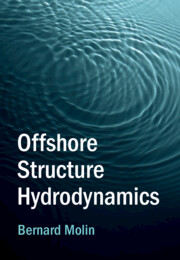Book contents
- Frontmatter
- Contents
- Preface
- Acknowledgments
- Symbols
- Abbreviations
- 1 Introduction
- 2 Environmental Conditions
- 3 Wave Theories
- 4 Wave and Current Loads on Slender Bodies
- 5 Flow-Induced Instabilities
- 6 Large Bodies: Linear Theory
- 7 Large Bodies: Second-Order Effects
- 8 Large Bodies: Other Nonlinear Effects
- 9 Model Testing
- Appendix A: Introduction to Potential Flow Theory
- Appendix B: Hydrostatics
- Appendix C: Damped Mass Spring System
- Appendix D: The Boundary Integral Equation Method
- Author Index
- Subject Index
- References
7 - Large Bodies: Second-Order Effects
Published online by Cambridge University Press: 31 January 2023
- Frontmatter
- Contents
- Preface
- Acknowledgments
- Symbols
- Abbreviations
- 1 Introduction
- 2 Environmental Conditions
- 3 Wave Theories
- 4 Wave and Current Loads on Slender Bodies
- 5 Flow-Induced Instabilities
- 6 Large Bodies: Linear Theory
- 7 Large Bodies: Second-Order Effects
- 8 Large Bodies: Other Nonlinear Effects
- 9 Model Testing
- Appendix A: Introduction to Potential Flow Theory
- Appendix B: Hydrostatics
- Appendix C: Damped Mass Spring System
- Appendix D: The Boundary Integral Equation Method
- Author Index
- Subject Index
- References
Summary
In this chapter the wave body interaction is extended to the second order in the wave amplitude. This leads to wave loads, and responses, taking place at the sum and difference frequencies of the components in the incoming wave system. The time averaged wave load (the drift force) is first considered in regular waves. The different formulations of the drift force (near-field, far-field, middle-field, Lagally) are described. The sensitivity of the drift force to a coincident current is emphasized and the extension of the diffraction radiation theory to a superimposed current is presented, together with the so-called Aranha’s formula that offers a practical approximation to the wave drift damping effect. Second-order diffraction theory is detailed in regular waves, with practical application to a bottom-mounted vertical cylinder. The concept of Quadratic Transfer Function (QTF) is first introduced in the case of bichromatic seas and then applied to the low frequency loading in irregular waves, where the validity of frequently used approximations (e.g. Newman approximation) is discussed. A section is then devoted to the Rainey equations which can be viewed as a second-order extension of the inertia term in the Morison equation. Finally practical calculation of the slow-drift and springing responses is considered.
Keywords
- Type
- Chapter
- Information
- Offshore Structure Hydrodynamics , pp. 219 - 286Publisher: Cambridge University PressPrint publication year: 2023

